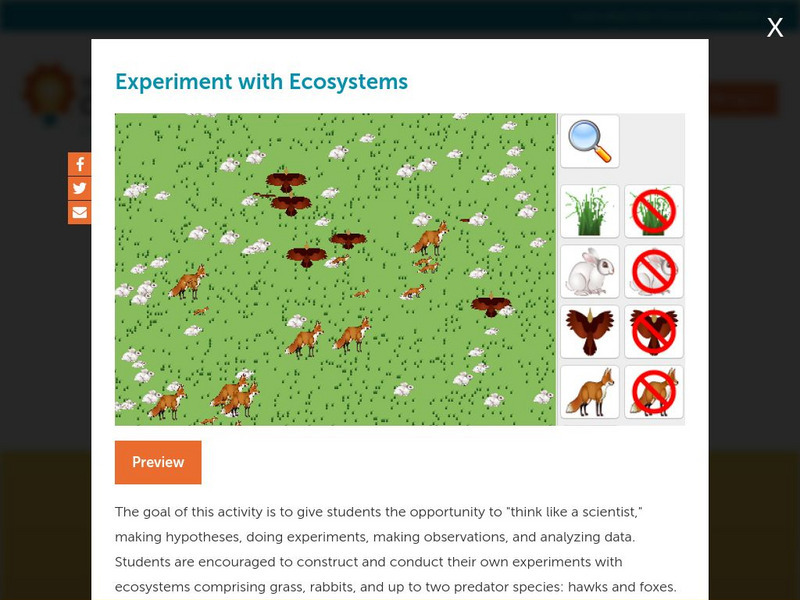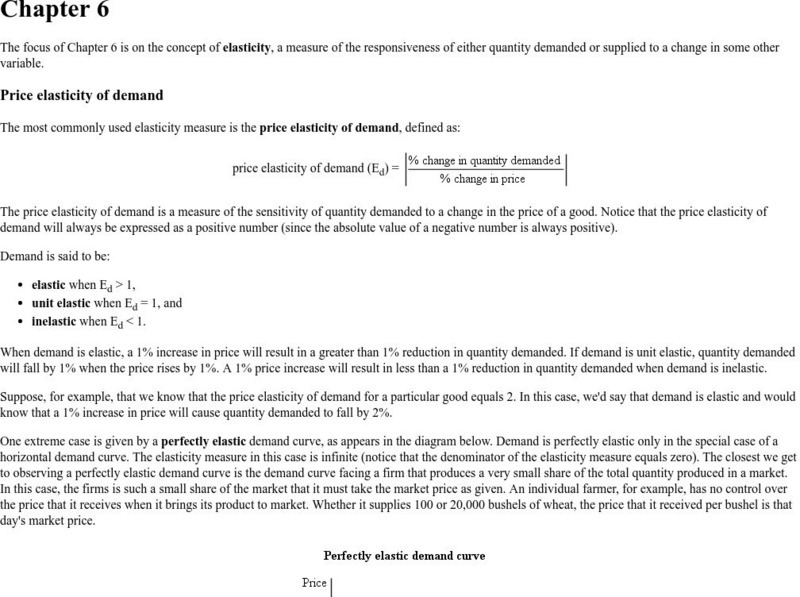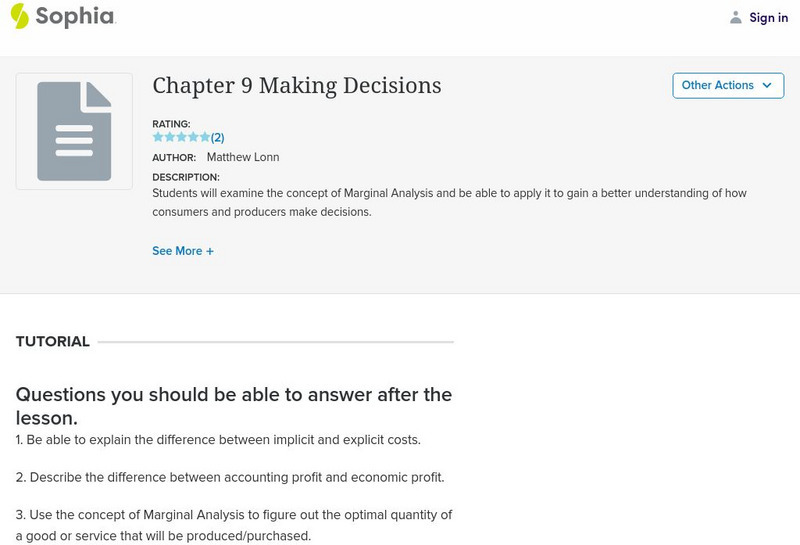TeachEngineering
Teach Engineering: Food Chains and Food Webs
This lesson, supported by the provided power point lecture (LESSON 1 and 2 Ecology Lecture Supplement ), introduces students to the concepts of food chains and food webs. Through its use, students learn the difference between producers...
University of Colorado
University of Colorado: Demand, Supply, and Markets
This site discusses in great detail the differences between demand, supply, and markets. Useful economic terminology is identified in bold.
Edutopia
Edutopia: Goods and Services [Pdf]
A unit that teaches the difference between goods and services, the difference between producers and consumers, the difference between human, natural, and capital resources, and the difference between bartering/trading and buying/selling....
Georgia Department of Education
Ga Virtual Learning: Digital Citizenship
Virtual learning resource on rights and responsibilities as consumers and producers of digital media and the internet. Click through the pages for more information. Includes handouts, audio, downlodable resources, assessment and activities.
CK-12 Foundation
Ck 12: Earth Science: Overpopulation and Over Consumption
[Free Registration/Login may be required to access all resource tools.] Looks at how the human population has grown. Some consume a tremendous amount of resources and produce a lot of waste.
iCivics
I Civics: The Market Economy
This lesson teaches the basics about the market economy, including the relationships between consumers and producers, supply and demand, and profit and incentive. Students learn six traits of a market economy, compare the market economy...
Louisiana Department of Education
Louisiana Doe: Louisiana Believes: Social Studies: Grade 2: Producers and Consumers
In this instructional task, 2nd graders develop and express claims through discussions and writing in which they explain how a person can be both a producer and consumer.
Louisiana Department of Education
Louisiana Doe: Louisiana Believes: Social Studies: Grade 3: Producers and Consumers
Read and study the sources about the roles that different people have in the Louisiana economy. As you read the three sources, think about what would happen if some people gave up those roles.
Concord Consortium
Concord Consortium: Stem Resources: Experiment With Ecosystems
Learn what happens to different populations of organisms as their ecosystem changes. Design your own experiment and make your own guesses with what the result will be with this virtual ecosystem. Also experiment with producer/consumer...
Other
Pde Sas: Relationships Among Organisms
In this lesson, students compare various types of relationships among organisms (i.e., biotic interactions). Students will: explain the roles of producers and consumers, and predators and prey in an ecosystem. Explain the levels of order...
Other
Microeconomics Chapter 6: Price Elasticity of Supply
Scrolling down towards the bottom of this site, there are equations, diagrams, and some general information concerning price elasticity of supply.
University of Nebraska Omaha
Ecedweb: Explorations in Economic Supply, Part I
Examines how supply relates to economic decision making. Using the example of purchasing blue jeans, students take the role of producer to determine how many blue jeans they would supply to the market. Includes links and discussion...
University of Nebraska Omaha
Ecedweb: Explorations in Supply, Part Ii
In this economics tutorial, you as a producer have to determine how much of a given product you should make.
Federal Reserve Bank
Federal Reserve Bank of St. Louis: What Is Driving Oil Prices?
As the world's demand for oil rapidly increases, so do the prices for it. Learn the factors causing high oil prices and who are the world's largest consumers of petroleum. Includes discussion questions. (Published Jan. 2005)
Science Struck
Science Struck: Difference Between Food Chain and Food Web
Explains the characteristics of food chains and food web; the different levels of producers, consumers, and decomposers; and the differences between food chains and food webs. Includes charts and a Venn diagram comparing the two.
Texas Instruments
Texas Instruments: Photosynthesis and Respiration
Students use the gas sensors to measure the amounts of oxygen and carbon dioxide consumed or produced by a plant during respiration and photosynthesis. They also determine the rate of respiration and photosynthesis in a plant.
Utah Education Network
Uen: Producing and Consuming
Lesson that helps learners understand the difference between producers and consumers. Students create booklets, making them producers, and then use the booklets to complete the lesson, making them consumers.
Other
The Learning Partnership: Journey to El Yunque
In this set of learning modules, students examine the impact of hurricane weather on the El Yunque rainforest in Puerto Rico. They learn about hurricanes, producers, consumers, and the food chain, and how disruptions in organisms'...
Sheppard Software
Sheppard Software: Parts of the Food Chain: Producers, Consumers, Decomposers
Learn how scientists classify different types of organisms in an ecosystem or in a food chain by their role and function as either a producer, a consumer, or a decomposer. Then play a game that tests your understanding of these important...
Robert Schenk, PhD
Saint Joseph's College: Supply and Demand Buyer Equilibrium
Summarizes buyer equilibrium. Then click Next button at the bottom to learn about seller equilibrium as well as shortages & surpluses.
Council for Economic Education
Econ Ed Link: Us and Eu Go Bananas Over Trade
Economists generally agree that free trade helps to improve the overall quality of life in countries that participate. However, disagreements do arise concerning trade agreements. This instructional activity looks at a disagreement...
Other
The Habitable Planet Simulation
This activity is designed to accompany an interactive on the Annenberg Learner website. Students investigate the changes that take place in an ecosystem when they alter the organisms in a food web. As they work with the simulation, they...
Science Struck
Science Struck: Learn All About the Ocean Food Chain
Read about the different predators, consumers, and producers that make up an ocean food chain.
Sophia Learning
Sophia: Making Decisions
Notes and a video clip provide students with an introduction to the idea of marginal analysis and of how consumers and producers make decisions.















